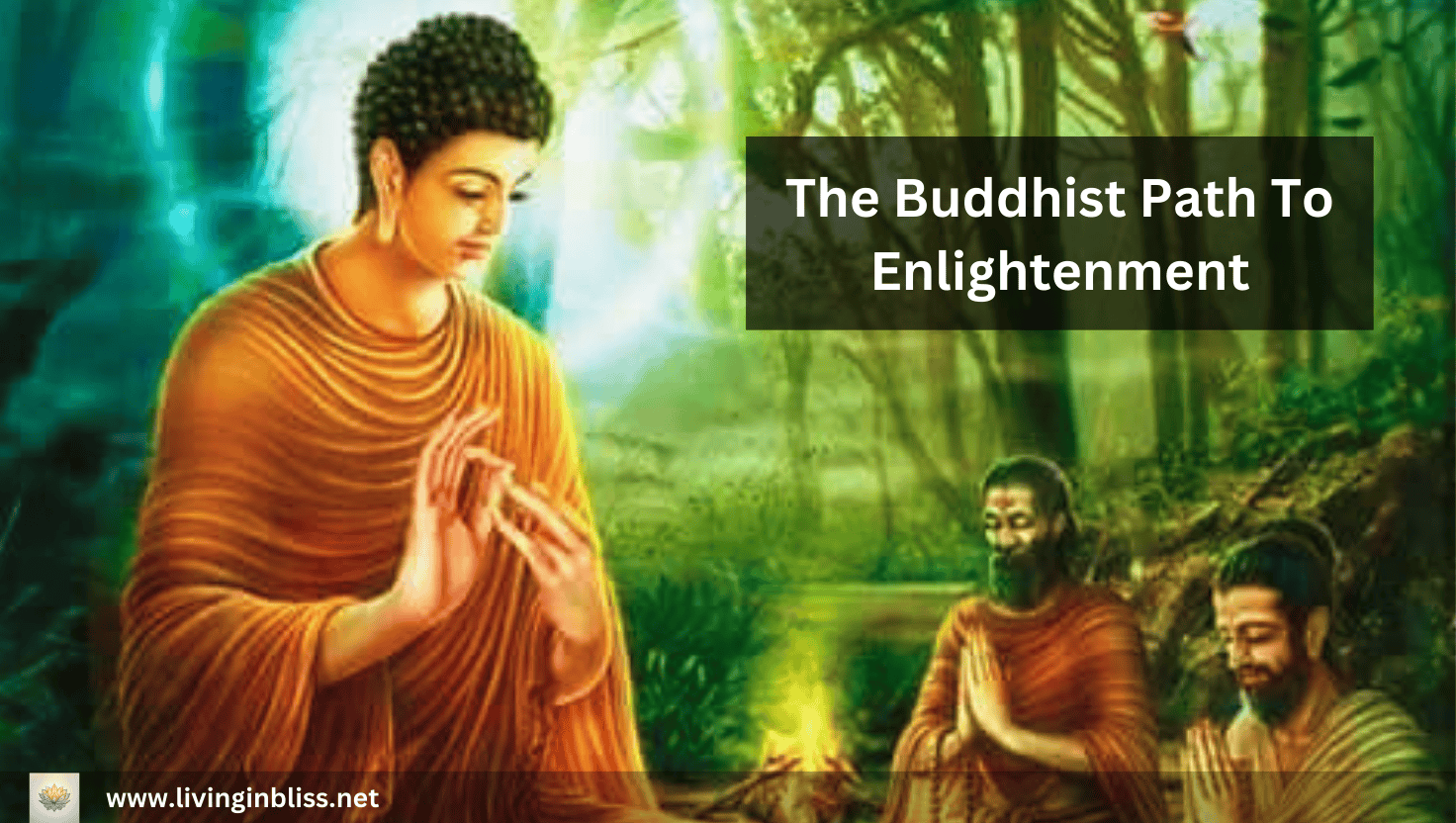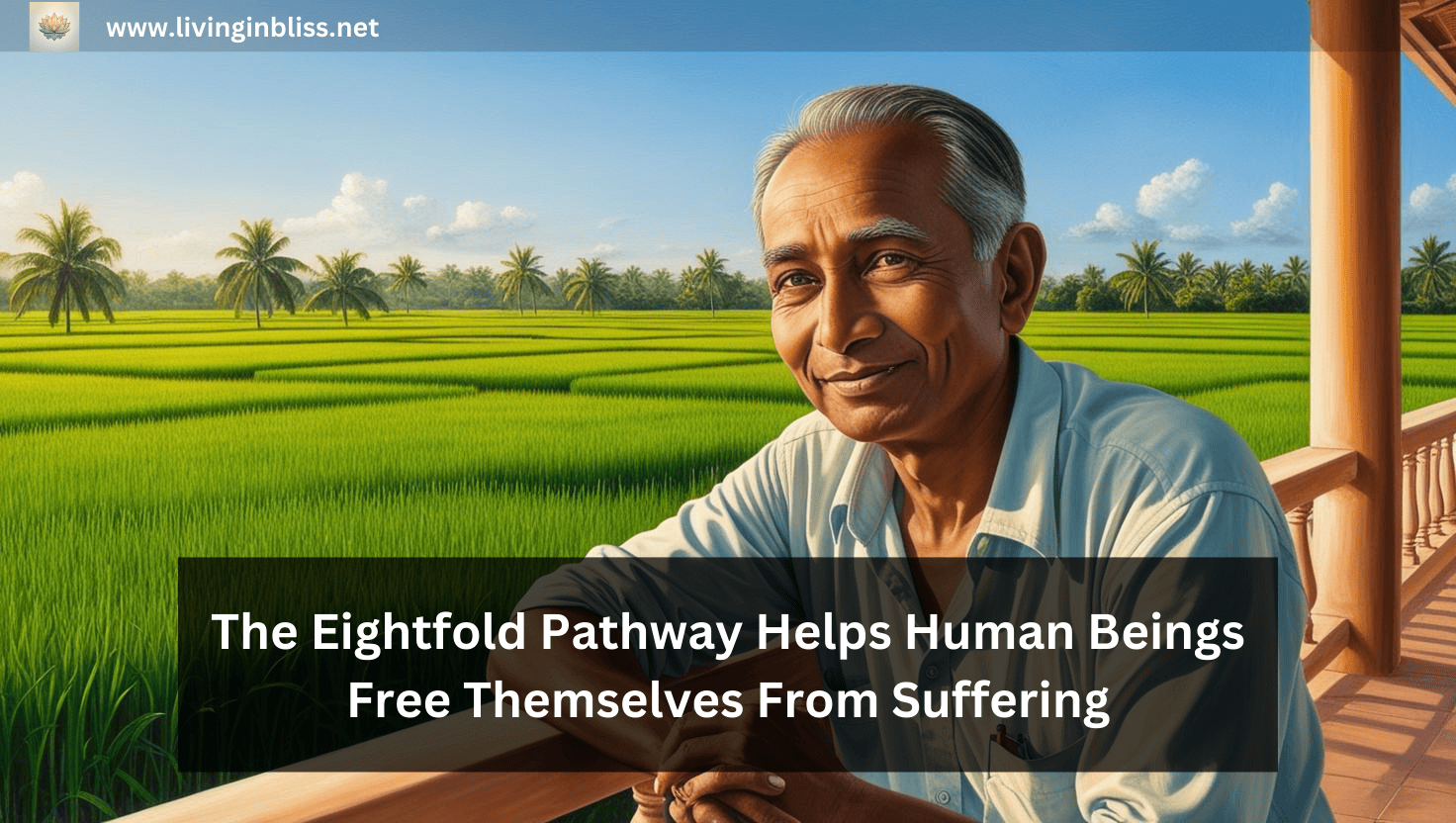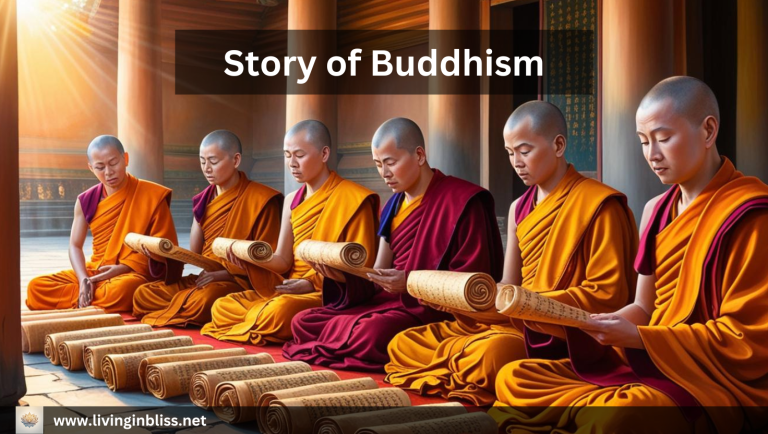The Eightfold Path | A Beginner’s Guide To Apply This Concept In Daily Life
The Eightfold Path is what Buddhism is based on. It gives the followers practical guidelines for a person’s ethical and mental development. This path ultimately leads to enlightenment and freedom from suffering. It consists of eight interconnected areas. Correct Understanding, Intent, Speech, Correct Action, Correct Livelihood, Correct Effort, Mindfulness, and Correct Concentration. Together, these elements provide a complete approach to a path where a balanced and mindful life is valued. Also, it encourages us to cultivate wisdom, mental discipline, and ethical conduct on our journey toward spiritual awakening.

Eightfold Path in Buddhism
The Eightfold Path is the basic concept principle in Buddhism and its teachings. That is what Buddha tried to teach the world. This concept spiritually guides ethical and mental development through examples of real life. It consists of eight interconnected areas. These areas are grouped into wisdom, ethical conduct, and mental discipline.
Here is a brief overview of each:
1. The Eightfold Path – Right View
The right view is the correct understanding of the Four Noble Truths, the theory of karma (the principle that explains the results of our actions have consequences), and impermanence. Also, it helps us to understand the interconnectedness of all spectacles. It recognizes the nature of suffering, its causes, and the path to its cessation.
2. The Eightfold Path – Right Determination
Right determination means staying away from harmful actions. We should develop kindness and goodwill toward all living beings. It also shows that we should cultivate non-attachment or non-harming.
3. Right Speech
False speech, harsh speech, divisive speech, and useless conversation are all considered unnecessary and harmful. They should be avoided. We should always use our words to tell the truth and promote compassion, harmony, and understanding toward each other while spreading kindness to everyone.
4. Right Action
This highlights ethical conduct and the importance of living a life that is in line with ethical moral principles. The teaching is to refrain from harmful actions, which include killing, stealing, sexual misconduct, and other nonethical and detrimental actions that fall into the same category.
5. Right Livelihood
Engaging in an ethical occupation is the right livelihood, which means choosing work that is combined with the principles of ethical conduct and does not cause harm to any living being. It also includes avoiding occupations that disturb or harm beings or engaging in dishonesty.
6. The Eightfold Path – Right Effort
Right effort means trying your best to cultivate wholesome qualities, avoid unhealthy ones, get away from negative mental states, and nurture or develop positive ones.
7. The Eightfold Path – Right Mindfulness
Right mindfulness is being fully aware and present at the moment. It involves a great understanding of observing our body, mind, and feelings. Our mental phenomena need to be clear and non-judgmental.
8. The Eightfold Path – Right Concentration
Right concentration is the development of a focused mind. This can be achieved by calming your mind and following the meditational practices. It will allow the mind to concentrate and focus on a single aspect, leading it to tranquillity and peace.
Following these eight elements will give the followers a detailed plan or a guideline for living a balanced, stress-free, and ethical life, guiding individuals toward spiritual awakening and freedom from suffering.
Right Understanding (Samma Ditthi)
Right Understanding (Samma Ditthi) explains the first element of the eightfold path; it is the understanding of the four noble truths, which is the basic theory of Buddhism. This will help identify and recognize the nature of suffering or Dukka, understand the cause or the reason for it, understand how to overcome it, and know which path to follow to get away from suffering. The right understanding helps us see reality. Also, this will help cultivate guidance and wisdom to make correct choices based on compassion and ethical living practices. By following this concept, we can develop a much clearer perspective of life that will reduce ignorance and delusion.
Right Intention (Samma Sankappa)
Right Intention (Samma Sankappa) is the second element of the Eightfold Path in Buddhism. It is cultivating the right mental attitudes and motivations that guide our actions. This aspect highlights three key intentions:
- Intention of Renunciation: Letting go of attachment and desire for material possessions and sensory pleasures.
- Goodwill will spread compassion and loving-kindness towards all living beings. It will always establish happiness and well-being.
- The intention of Harmlessness: Committing to non-violence and the desire to avoid causing harm to oneself and others.
By nurturing these intentions, we align our thoughts and actions with ethical conduct and compassion. It also helps us move closer to enlightenment and liberation from suffering. Right Intention is a foundation for moral behavior and mental clarity on the spiritual path.
The Eightfold Path – Right Speech (Samma Vaca)
Right Speech (Samma Vaca) is the third element of the Eightfold Path in Buddhism. It focuses on the importance of proper verbal communication and the impact of our words on ourselves and others. Right Speech involves:
- Speaking honestly and avoiding lies or deceit. Which is known as Truthfulness,
- Use gentle and compassionate words to spread harmony and understanding rather than conflict. It is known as kindness,
- Always having beneficial and meaningful conversations, steering clear of gossip, slander, and harmful criticism, known as constructivism.
- Being aware of the effects of our words and choosing them wisely promotes clarity and positive interactions, known as mindfulness.
Practising the Right Speech contributes to a more peaceful and supportive environment. It enhances their relationships and promotes understanding while reflecting inner integrity and mindfulness.

Right Action (Samma Kammanta)
Right Action (Samma Kammanta) is the fourth element of the Eightfold Path. Avoiding hurting others, stealing what is not given to you, and avoiding lying are some examples. It refers to ethical practices or conduct that help to promote human beings who nurture empathy and compassion. Minimizing harm is one of the best ways to achieve this.
Non-harming void taking life, which includes not killing or causing harm to any living being.
- Honesty: Avoid stealing or taking what is not given to you, cultivating trust and respect in relationships.
- Chastity: getting involved in actions that adhere to the boundaries of relationships, avoiding sexual misconduct, and fostering healthy interactions.
If you practice or follow the Right Action, we can cultivate good moral values and contribute to a compassionate and harmonious society. This element of the eightfold path enhances personal development and helps create a supportive environment for others. It also reinforces the interconnectedness of all beings on the path to enlightenment.
Right Livelihood (Samma Ajiva)
Right Livelihood (Samma Ajiva) is the fifth aspect of the Eightfold Path in Buddhism. It involves engaging in an occupation and living in a way that does not harm other living beings and is by ethical principles. The areas of Right Livelihood are discussed below.
- Avoiding Harmful Professions: Refraining from occupations or jobs that directly or indirectly cause harm and suffering to other living beings. These include jobs related to weapons, violence, exploitation, or deception.
- Promoting Well-Being: Choosing occupations that help positively to society, support the well-being of others, and foster compassion.
- Integrity in Work: Working on honest practices and ensuring one’s work is ethical and respectful. This also includes treating colleagues, subordinates, and clients with fairness.
Adhering to an ethical occupation or job lays a moral foundation for our lives. It aligns work with the spiritual values cultivated through Buddhism and contributes to a more humane and compassionate world. This principle encourages mindfulness in all aspects of life, strengthening the interconnectedness of one’s actions and the well-being of others.
Right Effort (Samma Vayama)
Right Effort (Samma Vayama) is the sixth element of the Eightfold Path explained by Lord Buddha. It discussed establishing a positive mind and avoiding unwholesome practices. The Right Effort has below four key areas.
1. Preventing Unwholesome States: Consciously avoid negative thoughts and emotions that can lead to harmful actions. The Buddhist followers achieve this by meditation, making effort, and stirring energy to have a peaceful mind. it is
2. Abandoning Unwholesome States: Actively working to let go of harmful thoughts and feelings that have already arisen. You need to try to avoid the toxic thoughts that would disturb your peace of mind.
3. Cultivating Wholesome States: Encouraging and developing positive qualities such as compassion, kindness, and mindfulness. Meditation is a good way to do this.
4. Maintaining Wholesome States: Sustain and deepen beneficial mental states through regular practice and mindfulness. Though this requires some effort, spreading kindness and compassion will help you achieve this state.
Practising these creates mental and emotional balance, clarity, resilience, spiritual growth, and the path to enlightenment discussed in Buddhism. This aspect helps in a positive approach to personal growth and development. Also, it emphasizes the importance of diligence and perseverance in one’s spiritual practice.
Right Mindfulness (Samma Sati)
Right Mindfulness (Samma Sati) is the seventh element of the Eightfold Path in Buddhism. It involves cultivating a deep awareness of or living in the present moment, including the areas below.
1. Awareness of the Body, which is paying attention to physical sensations, movements, and breath, builds up a connection between the mind and the body.
2. Awareness of Feelings is observing emotions as they are born and recognizing their nature without being greatly attached to them.
3. Awareness of the Mind and mental status helps understand the nature of thoughts. This allows us to accept them without judgment and recognize the path that leads to suffering.
4. Awareness of Mental Objects is a deeper understanding of the concepts, beliefs, and experiences through Buddhism, which allows for greater insight into the workings of the mind.
By practising the Right Mindfulness, we develop simplicity and insight, which help us respond to life’s challenges with wisdom and compassion. This aspect of the path encourages living in the present moment. It creates a deeper understanding of oneself and the world, which helps achieve enlightenment and freedom from suffering.
Right Concentration (Samma Samadhi)
Right Concentration (Samma Samadhi) is the eighth or the last aspect of the Eightfold Path in Buddhism. It is developing deep states of mental focus and clarity through meditation. Right Concentration is followed by:
- Focused Attention: Developing the ability to concentrate on a single object of meditation, such as the breath, a mantra, or a visualization, allowing the mind to settle and become calm.
- Jhana States: This is achieved through various stages of meditative absorption (jhanas), which lead to profound tranquillity and insight.
- Mental Clarity: This is gained by obtaining a state of mind with a clear awareness of minimizing distractions and disturbances. It also creates a deeper understanding and insight into the nature of reality.
- Insight Development: This state is achieved by using the stability gained through meditation and concentration to observe the true nature of phenomena, leading to greater wisdom and enlightenment.
Do you know what you gain by Practicing the Right Concentration? It improves our ability to focus and remain present. It helps deepen meditation and insight. If you have practised this, it will be of great help in overcoming ignorance and achieving a strong understanding of freeing ourselves from suffering.
These are the key Steps to enlightenment, as explained in Buddhism as the Noble Eightfold Path.
The Buddhist Path To Enlightenment

The Buddhist path to enlightenment is a transformative journey attempting to achieve philosophical wisdom and inner peace while being free from suffering. It is well explained through key teachings, notably the Four Noble Truths and the Eightfold Path. Here are the Eightfold Path and Four Noble Truths explained in brief.
1. Four Noble Truths
• Dukkha: suffering which is universal to all the beings who are born in this world. It could be a pain, illness, or mental disturbance that may cause the suffering.
• Samudaya: Understanding the reasons for suffering is the next step. If you are in pain or suffering, you should be wise enough to understand the reason for it.
• Nirodha: Realizing there is a way to end the suffering. If you have a deeper understanding of the reason, you will be determined to find a way to end the suffering.
• Magga: Follow the path that ends suffering. This is the last stage, and it is the stage where you will put all your learnings about the eternal truth to work to end suffering.
2. The Eightfold Path
This aspect has eight interrelated aspects grouped into three categories:
• Ethical Conduct (Seela):
o Right Speech is communicating truthfully and kindly.
o Right Action: Acting ethically and avoiding harm.
o Right Livelihood: Earning a living in a way that does not cause harm.
• Mental Discipline (Samadhi): o Right Effort: Cultivating positive states of mind and abandoning unwholesome ones.
o Right Mindfulness: Developing awareness of the present moment.
o Right Concentration: Fostering deep focus through meditation.
• Wisdom (Prajñā):
o Right Understanding: Grasping the nature of reality and the Four Noble Truths.
o Right Intention: Cultivating thoughts of renunciation, goodwill, and harmlessness.
3. Meditation Practices
Meditation is essential for developing concentration, mindfulness, and insight. It also has a strong link with Buddhist concepts as it helps to develop mindfulness. Various forms of meditation, including mindfulness and loving-kindness practices, help cultivate a clear understanding of the mind and reality.
4. Cultivating Virtues
Followers of Buddhism who follow different meditation practices always focus on developing qualities such as compassion, loving-kindness, and generosity, which enhance ethical conduct and the overall spiritual journey.
5. Insight and Awakening
This stage can be achieved through consistent practice and applying the teachings of the Eightfold Path in daily activities. We gain insights into the nature of existence, ultimately leading to enlightenment (Nirvana)—a state free from suffering, desire, and the cycle of rebirth.
The Buddhist path to enlightenment is a detailed approach that stresses personal responsibility, ethical living, and mental training. It helps individuals engage in self-reflection, cultivate mindfulness, and develop compassion, guiding them toward a deeper understanding of themselves and the world, which is the Core principle of Buddhism.

The Middle Way in Buddhism
The Middle Way, or Majjhima Patipada, is what Buddha followed to reach enlightenment. It refers to a balanced approach to life and living a practical life. According to Buddhism, it is getting away or living away from extremes, like self-indulgence and extreme pleasures. Here are some key aspects of the Middle Way:
The Buddha discovered the Middle Way in a harder manner. After experiencing both, he realized neither approach led to true understanding or enlightenment. The extreme practices of asceticism and a life of indulgence both taught him that they would lead him nowhere near what he was looking for.
The Middle Way encourages a balanced lifestyle that includes moderation in all aspects—pleasure, pain, desire, and renunciation. It teaches that extremes are the path to suffering and that balance fosters well-being.
Moreover, the Middle Way often leads in the Eightfold Path, which guides practitioners toward ethical conduct, mental discipline, and wisdom. By following this path, we can develop a good understanding without falling into the extremes of behavior or thought.
Mindfulness and Awareness of the middle path concept help everyone remain aware of their thoughts and actions. Do you know what you gain? It will also allow them to make their own decisions based on the concept of the Middle Way, avoiding reacting impulsively or habitually.
The Middle Way is described as the path leading to eternal bliss, freedom, and enlightenment (Nirvana). BAvoidingextremes can cultivate a life full of clarity, compassion, and kindness.
Overall, the Middle Way, according to Buddha’s words, encourages a practical and realistic life or way of living and emphasizes personal growth and understanding as pathways to spiritual growth.
Answers To The Frequently Asked Questions
1. What is the Eightfold Path in Buddhism?
The Eightfold Path in Buddhism is a guide to ethical living encouraged through ethical life practices. This is achieved through mental development. It helps humans free themselves from suffering and ultimately achieve enlightenment (nirvana).
2. Why is the Eightfold Path important?
Eightfold Path acts as a guide to those who are in search of spiritual growth and inner peace.
3. What is the Right Understanding (Samma Ditthi)?
This means having a clear mind about the reality of life; it is full of attachments and suffering and understanding the eightfold path as the guide to freedom from it.
4.What is Right Intention (Samma Sankappa)?
Right Intentions are the mental attitudes and intentions that guide one to take the right actions that do not harm another person or a living being.
5. What is Right Speech (Samma Vacha)?
Samma Vacha is the right speech that highlights the importance of communication. It expresses that all humans should speak ethically, truthfully, and compassionately to others.
6. What is the Right Livelihood (Samma Ajiva)?
It is earning a living in an ethically responsible manner.
7. What is the Right Effort (Samma Vayama)?
It is using positive efforts to help yourself and others and avoiding the unwholesome ones.
8. What is Right Mindfulness (Samma Sati)?
It is creating understanding and attention to the present moment of life.
9. What is the Right Concentration (Samma Samadhi)?
It helps you to practice mental focus that can be achieved through meditation.
10. How does the Eightfold Path lead to enlightenment?
The Eightfold Path provides a guide to freedom from suffering and helps one reach a state of eternal satisfaction.
11. How does the Eightfold Path relate to the Four Noble Truths?
Both concepts are interconnected and help human beings free themselves from suffering according to the Buddhist way of life.

The Eightfold Path – Conclusion
The Eightfold Path is the foundation of Buddhist teachings and the Buddhist way of living. It is a great concept that provides a comprehensive guideline for ethical living. Also, it encourages spiritual development and mental discipline; by following the aspects of Right Understanding, Right Intention, Right Speech, Right Action, Right Livelihood, Right Effort, Right Mindfulness, and Right Concentration, Buddhist followers cultivate the wisdom that is needed to follow the pathway to end suffering. What do you gain by following this concept? It helps to realize that compassion is necessary to understand and overcome suffering.
The Eightfold Path is the only way to enlightenment and eternal bliss. The light guides the followers of Buddhism toward achieving eternal inner peace and liberation from the cycles of craving and suffering.






